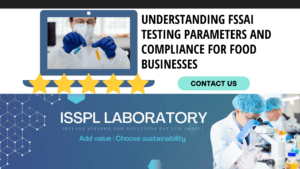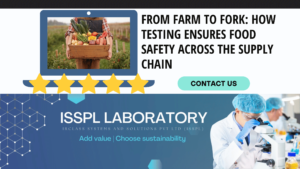An Overview by Team ISSPL - Analytical Testing Laboratory in India
ToggleMycotoxins are among the most studied biological toxins. Mycotoxins can contaminate foods at low concentrations and require a thorough check. With the increasing food threats and emerging risks at the industrial level, the analysis and extraction techniques need priority.
One must focus on the best analytical techniques and methods to detect and identify the mycotoxins in food products. The new-age testing techniques have become popular and effective for more reasons than one. The detection of mycotoxins needs a comprehensive approach to ensure public health safety. For instance, chromatographic techniques like high-performance liquid chromatography need the assistance of high-performance detectors like fluorescence, diode array, UV, etc.
The evolving techniques of mass spectrometry, and liquid chromatography are integral tools for reviewing and analyzing mycotoxins. With age, the use of rapid immunoaffinity-based detection techniques like immunoassays and biosensors has become popular. One can spot emerging technologies as well that involve genomic methods, molecular techniques, quantitative NMR, etc. All these are excellent solutions for the detection of mycotoxins in foods.
The growing need for testing
Mycotoxins are fungal toxins in field crops and feeds. They get formed in the field while harvesting and cultivation. The mycotoxins are susceptible to humid environmental conditions. The wet and humid climate is apt for the mycotoxin growth. The contaminated crops are toxic to humans and animals. These can generate adverse health issues and can be harmful to the consumer.
Several countries have established regulations and testing mechanisms to stop the spread of mycotoxins in food and feed. It is vital to find a reliable and efficient mycotoxin testing solution for the food and feed industry. In fact, effective mycotoxin testing measures can enhance the risk management procedure to the next level. It is ideal to conduct mycotoxin tests on raw materials and food ingredients before sending them to the production line.
Testing for mycotoxins could follow the rapid or reference methods. The new-age analytical methods and screening procedures, help identify and address mycotoxin contamination in the feed production chain. The test results are integral for ensuring the optimal safety of the food and safeguarding the health of consumers.
Food safety and mycotoxin testing
Mycotoxin risk management needs a proactive approach, and it is a continual journey towards enhanced food safety. One needs to abide by the necessary procedures that help prepare you for potential feed contamination by mycotoxins. Apart from the instant solutions of rapid testing, reference testing has made a significant impact on effective mycotoxin management.
The high-performance liquid chromatography or HPLC and Liquid chromatography-mass spectrometry methods are apt for reference testing. In mass-spectrometry tests, the tester follows a comprehensive approach to provide in-depth analysis. The test results of food materials deliver a detailed insight into mycotoxins. The comprehensive method is more effective than the swift testing mechanism.
Contamination – How does it spread?
Identifying the apt ways to fight mycotoxin contamination is the foremost concern. While purchasing feed, the suppliers need to follow reliable measures to ensure optimal quality. However, the quality does not guarantee a contamination-free feed. The exclusive way to manage the risks is by following the end-to-end testing steps for the feed.
The test results help ensure safety to the next level. Did you know that contamination is possible in transit? It is essential to test and ensure the best safety measures. The raw materials get transported in bulk, and external elements can enter the materials before feed processing.
Identify the risks
The contamination risk depends on the chemical levels. The chemical composition reflects the possible presence of mycotoxins. The naturally-occurring molds and fungi in agricultural commodities need the best risk management solution. It is not ideal to underestimate the danger of contaminants, like mycotoxins. The symptoms of mycotoxin poisoning are challenging to review and identify, and thus, one needs a careful approach. Prolonged exposure to such toxins can be fatal for the body.
The ideal testing techniques to follow
The testing and laboratory analysis of mycotoxins is comprehensive and complex. Mycotoxins are heterogeneously distributed in distinctive quantities in agricultural commodities, foods, feeds, etc. These are also found in biological samples with varying chemical components. The dynamic composition and presence of the mycotoxins make the extraction, identification, separation, and detection techniques integral.
The growing need for high-sensitivity tests to analyze and identify the levels of mycotoxin is significant. Especially for regulatory purposes, the testing steps have become more critical than ever. Combined with efficiency, the high accuracy of the testing steps has facilitated the food safety index to the next level. The end-to-end steps of mycotoxin lab analysis are apt to quantify the toxin levels for risk assessment, identification, and mitigation.
- ELISA – The enzyme-linked immunosorbent assay or ELISA technique utilizes specific antibodies in the sample to detect the target molecule. In the ELISA test, the target molecule reacts with the antibody and produces a visible result.
- Rapid test – The rapid screening methods are part of the immunochemical techniques. The rapid detection of mycotoxins uses the advanced immunosensors. The rapid testing process does not need extensive sample cleanup and cultivation steps.
- Spectrometry – Liquid chromatography with the help of mass spectrometry (LC/MS) is an effective lab-based technique that facilitates the selective determination of more than one mycotoxin in complex matrices.
- Gas chromatography – Gas chromatography is an efficient testing method to review and identify mycotoxins that can turn into gas within the chromatography column. Gas chromatography combined with electron capture detection, or ECD, and flame ionization detection can help identify trichothecenes or patulin mycotoxins.
- High-performance chromatography – It is the most used testing method for mycotoxin determination. High-performance liquid chromatography (HPLC) is an advanced solution for enhanced sensitivity, precision, and automation solution.
Make an informed choice.
It is integral to ensure optimal food safety. Identifying the contaminants and treating them with the ideal tools helps make the food safe from contamination by aflatoxins and other types of mycotoxins.
Ensure the best testing solution with the reputable and reliable lab-testing services offered by IRCLASS Systems and Solutions Pvt Ltd (ISSPL) laboratory. The state-of-the-art testing infrastructure helps deliver accurate results for industrial requirements.







